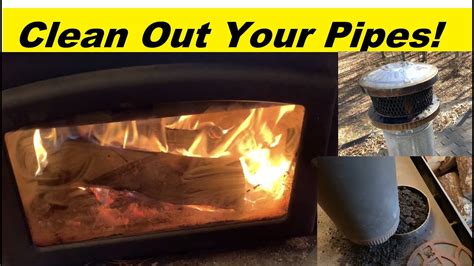Effortless Wood Stove Pipe Cleaning: Simple Techniques
Maintaining a clean wood stove pipe is crucial for safety and efficiency. Creosote buildup, a byproduct of wood combustion, is highly flammable and can lead to chimney fires. Regular cleaning prevents this hazard and ensures your stove operates at its peak performance. While professional chimney sweeps are invaluable, many aspects of wood stove pipe cleaning can be tackled with simple techniques and regular maintenance. This guide outlines effortless methods to keep your chimney safe and your stove burning efficiently.
Why is Cleaning My Wood Stove Pipe Important?
Creosote accumulation is the primary reason for cleaning your wood stove pipe. This sticky, black substance forms when wood doesn't burn completely. Over time, it builds up on the interior walls of your chimney, creating a fire hazard. A significant creosote buildup can easily ignite, leading to a dangerous chimney fire. Beyond safety, a clogged pipe reduces draft, making your stove less efficient and potentially producing more smoke in your home. Regular cleaning ensures optimal airflow, maximizing heat output and minimizing fuel consumption.
How Often Should I Clean My Wood Stove Pipe?
The frequency of cleaning depends on several factors, including the type of wood burned, the stove's efficiency, and the amount of use. However, a good rule of thumb is to inspect your chimney at least once a month and perform a thorough cleaning at least once a year, or more frequently if necessary. Signs that your chimney needs cleaning include excessive smoke in your home, a noticeable decrease in the stove's efficiency, or a visible buildup of creosote in the chimney cap or visible portions of the pipe.
Simple Techniques for Effortless Wood Stove Pipe Cleaning
Several methods can help simplify the process of cleaning your wood stove pipe. Remember, safety is paramount. Always ensure the stove is completely cool before attempting any cleaning.
1. Preventative Measures: The Easiest Cleaning Method
The best way to deal with creosote is to prevent its excessive buildup. This involves burning only seasoned hardwood, ensuring proper airflow, and regularly checking your stovepipe for creosote accumulation.
- Seasoned Hardwood: Properly seasoned wood burns more efficiently and produces less creosote. Aim for wood that has been dried for at least six months to a year.
- Proper Airflow: Make sure your stove's air intake vents are open correctly to allow sufficient oxygen for complete combustion. A well-ventilated space is also critical.
- Regular Inspections: Monthly visual checks can help detect early signs of creosote buildup. Use a flashlight to inspect visible portions of the pipe for any significant accumulation.
2. Using a Chimney Brush: The Standard Approach
A chimney brush is the most common tool for cleaning wood stove pipes. Choose a brush that's the correct diameter for your chimney flue. The brush should be stiff enough to remove creosote but not so stiff that it damages the pipe. Many chimney brushes feature a weighted end to aid in the cleaning process.
- Attaching the Brush: Secure the brush to a long, flexible rod designed for chimney cleaning.
- Cleaning Process: Insert the brush into the chimney top and carefully work it down, rotating it to scrub the interior walls. Repeat several times, then slowly remove the brush.
- Removing Debris: After brushing, you may need to use a shop vacuum with a long attachment to remove the dislodged creosote.
3. Using a Chimney Cleaning Kit: A Comprehensive Solution
Chimney cleaning kits typically include a brush, rods, and accessories to make the process easier and more efficient. These kits offer a comprehensive approach to cleaning, often including a flexible rod that can navigate bends and turns in the chimney.
4. Understanding When to Call a Professional
While these methods are helpful for maintaining your wood stove pipe, there are situations where professional assistance is necessary. If you encounter significant creosote buildup, have a complex chimney system, or feel uncomfortable attempting the cleaning yourself, it's best to call a certified chimney sweep. They have the expertise and equipment to handle challenging situations safely and effectively.
What are some common signs of creosote buildup in my wood stove pipe?
Excessive smoke entering your home, a noticeable reduction in your stove's heating efficiency, and visible creosote buildup in the chimney cap or accessible parts of the pipe are all clear indicators of a problem that needs attention.
What type of wood is best to burn in a wood stove to minimize creosote buildup?
Seasoned hardwood, such as oak, maple, or hickory, is ideal. These woods burn more efficiently and produce less creosote compared to softwoods or unseasoned wood.
Can I use a shop vacuum to clean my wood stove pipe?
While a shop vacuum can help remove loose creosote after brushing, it's not suitable for primary cleaning. A chimney brush is essential for removing creosote buildup from the pipe's interior walls.
Conclusion
Regular cleaning of your wood stove pipe is a critical aspect of safe and efficient wood burning. By employing these simple techniques and understanding when professional assistance is required, you can keep your chimney safe, extend the life of your stove, and enjoy the warmth of a well-maintained wood-burning system. Remember, safety always comes first! If you have any doubts or concerns, consult a qualified chimney professional.

